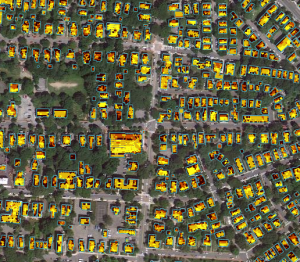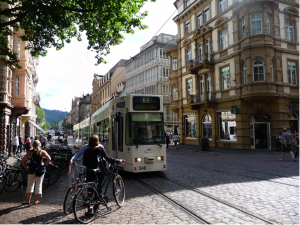
Kaiser Joseph Strasse, in Freiburg Center
I’m on a personal study tour of Germany and Holland to see what German and Dutch cities are doing about reducing greenhouse gas emissions and adapting to climate change. The tour is organized by ICLEI-Local Governments for Sustainability, an organization that the City of Cambridge has been a member of since 1999. Our tour leader, Jade Jackson, is leading our group of 4 Canadians and 2 Americans through Freiburg and Dresden Germany, and then on to Bonn to attend the ICLEI Climate Resilient Communities conference. We will end up in Rotterdam in The Netherlands. I thought I would try to share what I see and learn along the way. I hope you find it useful and interesting.
In Cambridge, we often look to Europe for examples of how to make the city more sustainable given that we are a dense urban community that in many ways is more similar to European cities than American. On this tour, I’m looking to see how the cities here have implemented actions that we have thought about, and actions that we have not even considered yet, particularly in regard to adaptation.
Freiburg, of the Black Forest, is our first stop. It might be the greenest city in Europe [or the world?]. Renewable energy is a big focus here. But they also have a very admirable sustainable transportation system, waste management, and land use.
Freiburg’s old city center was largely destroyed in World War II. About 80% of the city center was bombed toward the end of the war. After the war, the city decided to keep the historic street pattern and re-build on the foundations of the destroyed buildings, reconstructing in the historic style. Much larger new development surrounds the old city, but within the city boundaries there are large areas devoted to farms, vineyards, and protected forests; about half of the city is open space. Today, Freiburg is a growing city of about 220,000 people with a major university and service base.
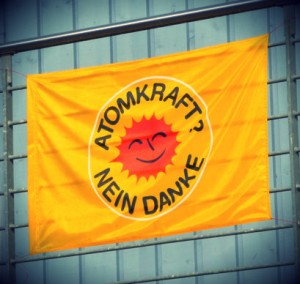
"Nuclear power, no thank you."
We met with Franziska Breyer, of the City’s environment agency, who presented the history and overview of the city’s sustainability efforts. Freiburg’s green movement began with anti-nuclear protests in 1973, when new nuclear plants were proposed just across the border in France and nuclear waste storage was proposed nearby in Germany. Those protests led to people thinking that they could not just be against nuclear power, but need to be for something. I visited Freiburg 30 years ago as I was involved myself during college in anti-nuclear protest at home and wanted to see what the fuss was about here. Ironically, as we arrived in Freiburg last weekend, there were again anti-nuclear protests taking place as the Conservative government reconsidered its nuclear policy in the wake of Fukushima and reversed course, deciding to plan to phase out nuclear energy by 2022. So I imagine the protests were part celebratory.
The alternatives Freiburg has come up with encompass energy efficient construction, solar energy, district energy, wind energy, biomass, a well-integrated, multi-modal transportation system, and waste reduction practices. I’m sure we didn’t hear about everything.
Freiburg has set a goal in 2007 to reduce greenhouse gas emissions by 40% below 1992 levels by 2030. As of 2009, the city has achieved an 18.6% reduction. The municipal government has a climate protection budget of 1.2 million Euros, which is largely funded by annual payments from utilities for use of public space for infrastructure. The budget does not include additional funds set aside for energy efficiency subsidies provided to residents (21 million Euros since 2003), investment in public facilities and infrastructure, transportation, and other services.
Frau Breyer talked about the sustainability concept that the city’s efforts are based on. While it is common to think of sustainability in terms of balancing the 3 “E’s” – ecology, economy, and equity, she said in Freiburg they see sustainability as fundamentally based on ecology and that this is not negotiable. Without a sound ecology, there cannot be a viable economy and equitable society. The economy and social welfare flow from this sound ecological base.
The city is working to grow its green economy. The green city initiatives are seen as a factor in attracting green businesses to locate in Freiburg. There are about 1,500 green businesses employing about 10,000 people. Of those ten thousand, about 1,500 people are employed in the solar energy sector.
The energy strategy is based on energy saving, efficient generation, and renewable energy. About 10% of the electricity is supplied by nuclear in Freiburg. About half is produced by co-generation units that also provide heat through district heating systems. In addition to larger co-gen units, there are about 90 small CHP units around the city.
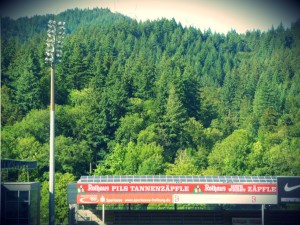
Badenova Sports Stadium roofs covered with Solar PV
Solar energy is very visible around Freiburg. Currently 12.3 MW of solar capacity is in place, producing over 10 million kilowatt-hours annually. For context, the City of Cambridge consumes about 40 million kwh of total electricity annually,which is a small percentage of total use in Cambridge. Cambridge has close to 1 MW of solar PV in place. In Freiburg, solar thermal panels cover about 15,000 square meters. Solar PV has been ramped up by very generous feed-in tariffs created by the federal government, which pays owners for the electricity production. The federal government is now moving to phase out the feed-in tariffs as they believe they have served their function of creating a solar industry. We were told that while the feed-in tariffs have been successful in expanding the use of solar PV, the price of solar PV has not really decreased, which was one of the goals of the policy. And while solar panels are a common sight in Freiburg, they are installed on a minority of buildings.
There are 5 medium sized wind turbines installed on the hills around the city. They produce 14 million kwh every year, more than produced by all the solar PV panels.
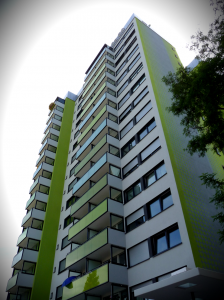
Bugginger StrasseHi-Rise, first to meet Passivhaus energy standards
We were told that increasing efficiency in existing buildings remains a challenge. The City has invested 21 million Euros since 2003, which has leveraged an additional 23 million Euros. Generally the funds have been used toward efficiency improvements when buildings are undergoing major renovations. This investment has reached about 3 to 4% of the building stock.
The Vice Mayor said they see the future trend being toward more short-distance district heating, noting the high cost of installing infrastructure, and more micro-CHP.
There is more to admire in Freiburg’s energy practices, including their eco-villages with buildings meeting Passivhaus standards and Plus Energy houses.
Upcoming: Sustainable Transportation and Freiburg’s eco-villages – Vauban and Rieselfeld.


